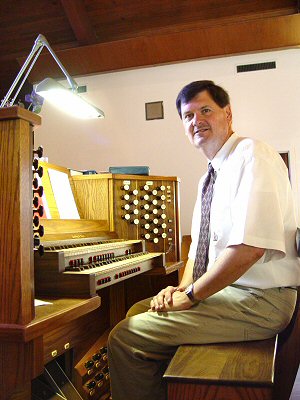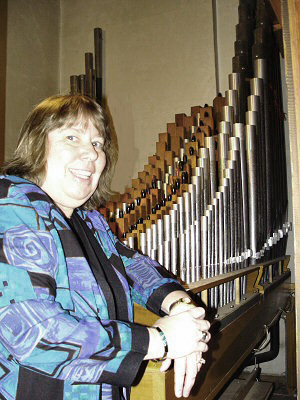Goulding and Wood Pipe Organ
First English Lutheran Church, New Orleans, LA.
Dedicated October 3, 1993 - Removed for installation in new Metairie
church August 10, 2003
All stops 61 pipes unless otherwise noted
GREAT ORGAN 8' Principal |
SWELL ORGAN 8' Rohrflote |
| PEDAL ORGAN 32' Untersatz (added 1991) |
COUPLERS Swell to Great 16, 8,4 COMBINATIONS Hand: Toe:
|
| REVERSIBLES Swell to Great |
PEDAL MOVEMENTS Balanced pedal for Swell Organ |
 |
 |
Dr. Tom Mitts plays the final
service and concert on the Goulding and Wood before its removal in preparation
for the church's relocation to the new Metairie sanctuary. |
Ellyn Meier,
curator of the organ and producer of the popular First English Lutheran
Church Concert Series. |
HISTORY OF THE FIRST ENGLISH LUTHERAN CHURCH ORGAN First mention of an organ for the church was found in a letter of November 28, 1888 in which First English Choir requested a buy-out agreement for their share of a reed organ purchased by the St. Paul Lutheran Church Choir. It is not directly known if an agreement was ever reached, however, in 1889, a "Chapel Organ" built by Carl Barckhoff, was installed in the choir loft of the first church building. The instrument had 2 manuals, 12 ranks, and about 700 pipes. The specification was typical of small, mass-produced organs of the day that could be ordered from a catalogue. That organ was relocated to the congregation's second church building in 1893, where it remained unchanged for 63 years with the exception of the addition of an electric blower in 1902. The organ console story began with a move to a new church in 1956. At that time, it was decided that the Barckhoff Organ would be kept. Rive and Rive of New Orleans was hired to move the organ to the new church, locate it in two chambers, and to electrify the stop and key actions. A new Moller console was added at that time. The organ was named after Dave Rodriguez, who had served as organist and choir director for 40 years previously. In the early 1970's it was realized that the Barckoff was tonally dated and worn out, having been damaged by Hurricane Betsy in 1965. The Rive Company was selected to provide the present organ using the existing chambers, swell shades, and the Moller console. An entirely new chest was constructed for the Great division and pipes, manufactured by Stinkens and Zeist of the Netherlands, were added. Additional chests and ranks , coming from a fire salvaged organ originally in Lawless Memorial Chapel of Dillard University, were also added as was a trumpet chest from an unknown E.M. Skinner organ. The finished organ contained 19 ranks of 1125 pipes that remain in the present installation. The organ is finished in the American Classic style, which is typified by instruments on which a variety of organ literature may be interestingly and convincingly performed. Through the attention and guidance of then organist Ed Donelly, the compromises, usually associated with such projects, was avoided and the organ remains a total success. The pipes and chests of the original Barckhoff organ were surrendered to Fort Worth organ builder Roy Redman, who used much of the pipe work in his Opus 25 located in St. Matthew United Church Of Christ in New Orleans. By 1990, it was apparent that the Moller console of 1956 was in need of refurbishment and repair, and there was a desire to again expand the organ. With this in mind, the Church Council authorized then organist Michael Christiansen to obtain bids for a new console including up-to-date technology and room for expansion. A number of measures were attempted to keep the Moller console operating, however after a failure of the combination action and subsequent fire hazard, contracts were signed with the Goulding and Wood Company to provide a new console containing solid-state combination action. The keyboards and pedal clavier were built in England of oak and rosewood. In August of 2003, preparations were made to move the organ to a new church being built in Metairie. The organ was removed from service and placed into storage by Dr. James Hammann, assisted by a crew of volunteers from the congregation. Dr. Thomas Mitts, who dedicated the Goulding and Wood console, returned to play the final concert in the church's 1956 sanctuary.
|
|